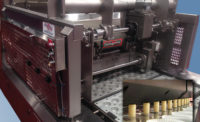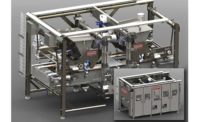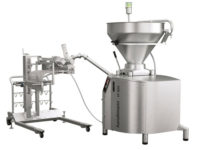Sanitation, automation, efficiency, speed, ease of cleaning, the ability to handle larger capacities, and the ability to produce clean label-foods are among the top priorities for snack food and baked goods makers seeking to purchase dividers, depositors and rounders.
Industry feedback
Consumers interested in healthy eating are driving many of the requests from customers of Fritsch Group, Markt Einersheim, Germany, according to Stefan Praller, head of marketing. “Today’s consumers of baked goods are increasingly demanding breads and rolls that are free from additives,” he says. “Producing these clean-label foods requires increasingly hydrated doughs with pre-proofing times far in excess of two hours. Such doughs have a higher water content and are, therefore, softer and highly developed, giving them a tendency to stick. All this, of course, is placing new demands on the machines processing the dough.”
Unifiller, Delta, British Columbia, keeps hearing about the need for greater sanitation and more automation, which has led to a noticeable demand for servo control, says Andy Sigrist, special projects manager. “There will be less demand for pneumatic depositors,” he predicts. “That ties in with automation and recipe control. It’s not just for recipes—it’s for more-accurate portioning, more-accurate spreading and automated modes.”
Customers of Hinds-Bock, Bothell, WA, are also looking to increase efficiency and production, while reducing ingredient cost and product waste, which typically leads them to consider servo-driven depositors, says Lance Aasness, executive vice president. “These are easy to assemble and disassemble in a matter of minutes for full washdown, and they are recipe-driven, meaning that on the color touchscreen, you simply select a recipe and away you go,” he says. “It will remember the parameters that were set for that particular recipe.”
Reiser, Canton, MA, also has seen an emphasis on waste reduction and line efficiency, says John McIsaac, vice president of strategic business development. “Bakers want machines that scale accurately, leave little waste at the end of the day, and start and stop with the lines,” he says. For example, on a dual lane bread line, if one moulder goes down, they want a divider that can recognize this development and stop dividing on that lane—and then automatically discharges the dough so it doesn’t get stuck upstream.
Customers of Koenig Bakery Systems, Ashland, VA, increasingly have been requesting lines with larger capacities, enabling them to save investment costs with only one high-performance line that features a wide variety of buns and rolls, says Richard Breeswine, president and CEO. This has prompted companies like his to try to square the circle between lines with high quality and modularity but limited capacity, and lines with high capacity that lack the ability to process doughs with longer bowl resting time or heterogeneous dough structure, including nuts or raisins, for example, he says.
New and improved
In recent months, Fritsch has rolled out the SDS Soft Dough Sheeter system, which processes doughs with a yield of around 165 to 190. Praller says this machine offers precise portioning and positioning with reduced drop heights, and gentle processing for a continuous dough sheet with very high weight accuracy. “The system requires very little oil from beginning to end, resulting in a hygienic process that ultimately pays off for low cleaning requirements,” he says. The SDS also has a compact design that can be dismantled without tools and wet-cleaned.
Unifiller, which handles batter depositing, has brought greater sanitary design to customers in the foodservice sector with the Universal 1000-I FoodService. Sigrist notes that foodservice environments typically have higher sanitation standards than many bakeries. This has meant the use of stainless steel instead of aluminum to guard against the “harsher environments” in foodservice, as well as offering a design with fewer crevices and corner, sloped covers and “different pneumatics” to account for the condensation that occurs in colder environments, he says.
Another recent offering from Unifiller has been the Servo Multi Depositor, which improves upon older models in that it’s faster to set up and provides automated recipe functionality. “Any employee can be trained to select the recipe,” Sigrist says. The servo depositor also provides features like slower starts for products that tend to splash, and a linear actuator that precisely moves pistons for products that need to have something spread on top of them, he says.
Koenig has introduced the T-REX AW dough dividing and rounding machine, which provides an output of up to 72,000 pieces per hour in a 12-row operation, most frequently used for high-volume products like hamburger and hot dog rolls, doughnuts, or cut rolls, Breeswine says. With a weight range of between 25 and 70 grams, the T-Rex AW can process a range of products, such as doughs with a longer bowl resting time, those with a higher yield, and those with ingredients like raisins, nuts or chocolate pieces.
The machine achieves 100 strokes-per-minute performance with specially designed ledges where the dough moves after it’s divided, turned and transferred to a spreading finger belt for resting. The belts are extractable for purposes of cleaning and maintenance, and the rounding ledges can be exchanged without tools and also removed for sanitation purposes. The T-REX AW “combines modularity and product variety with gentle dough processing and high performance,” Breeswine says.
Hinds-Bock has continued to expand its family of servo-motor-driven piston and pump filling machines with the Single Piston Servo Pump Filler and Multi Piston Servo Fillers and Depositors, Aasness says. “Because the servo motors are recipe-driven, the end result is having much more control of the delivery and appearance of product, higher yield, increased consistency and less ingredient waste,” he says. “This is especially important when trying to spread the deposit of a product out laterally and end-to-end.”
The piston transfer pumps produced by Hinds-Bock work 24-7 to pump flowable product from bowls, pails and other containers into depositor hoppers quickly and gently, while allowing easy, tool-free sanitation and maintenance. “Common products that Hinds-Bock can pump are batters with or without inclusions,” Aasness says, “such as whipped and aerated creams and batters, sauces, flowable chocolate and fruit fillings, and sauces with or without chunks and inclusions.”
Reiser has introduced a new iteration of the Vemag HPE divider, which is outfitted to the patented double-screw with a new infeed that’s 40 percent larger than the previous model. That improvement “means we can fill our double-screw much more easily, which equals gentler handling,” McIsaac says. “We are able to produce breads and rolls with greater volume and more-open crumb.” The machine also accomplishes this without compromising the scaling accuracy.
The company also has rolled out the VPC 715 Process Check, which helps measure the changes in characteristics that large batches of dough undergo from start to finish, given that dough is a live product. “The Process Check alerts the Vemag to a change in product density, and the Vemag adjusts the scaling automatically,” says McIsaac. “Additionally, the Process Check captures the production and weight data. The data is easily extracted No longer do you need to be an automation engineer to adjust and extract data.”






